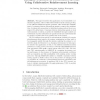34 search results - page 6 / 7 » Learning Policies for Embodied Virtual Agents through Demons... |
JMLR
2002
14 years 11 months ago
2002
Lyapunov design methods are used widely in control engineering to design controllers that achieve qualitative objectives, such as stabilizing a system or maintaining a system'...
140
click to vote
BERTINORO
2005
Springer
15 years 5 months ago
2005
Springer
Abstract. This paper describes the application of a decentralised coordination algorithm, called Collaborative Reinforcement Learning (CRL), to two different distributed system pr...
CHI
2009
ACM
2009
ACM
Social immersive media: pursuing best practices for multi-user interactive camera/projector exhibits
16 years 5 days ago
Based on ten years' experience developing interactive camera/projector systems for public science and culture exhibits, we define a distinct form of augmented reality focused...
ALIFE
1998
14 years 11 months ago
1998
Creating artificial life forms through evolutionary robotics faces a “chicken and egg” problem: learning to control a complex body is dominated by problems specific to its s...
NECO
2007
14 years 11 months ago
2007
Learning agents, whether natural or artificial, must update their internal parameters in order to improve their behavior over time. In reinforcement learning, this plasticity is ...


